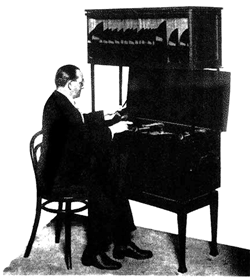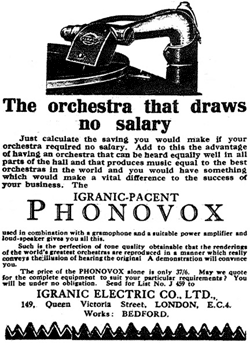|
Two
Turntables and a Microphone |
||
|
The
shorter, funnier version of my dissertation History, and especially the history of technology, usually tries to construct a linear story that lead us neatly to the present day via a succession of key events or innovations. But some technologies, no matter how successful in the short term, do not fit the long term story arc. They are superseded in the evolutionary chain and forgotten. The mini-disc will probably suffer this fate. Think about the 1920s. Silent films. Seen Singin’ In The Rain? Sound films sweep the board overnight. Talkies, Talkies, Talkies! In the US things moved fast. The whole industry was dominated by five companies, who controlled production, and owned their own chains of cinemas. They could afford to invest in the sound equipment to make the new kind of films, and the new sound projectors for their theatres. In Britain the film industry was pathetic. Less than 5% of films shown were made in the UK, and Hollywood product made up most of the rest. Of the 4,000 cinemas in the UK, 3,000 were independently owned and run. Business was pretty bad, and getting worse each year, but the cinema owners (exhibitors) didn’t care who made the films as long as they were popular. They looked wistfully at their balance sheets for the First World War period, when 20m people a week paid to see whatever was available. Exhibitors moaned (about taxation), and worried (that the public would forget films and go ice skating instead). They needed gimmicks, but cheap gimmicks. The cheaper the better. In the 1920s people went to the pictures without much regard for what was on, or when it started. Films ran continuously - you just turned up. Punters would base their choice on the comfort of the cinema and the quality of the music and how much they could afford. In fact the musicians’ wages could account for as much as a third of weekly costs. The popular image of the single plinky plonky piano accompaniment was what you got only in the crappest local fleapit. Most cinemas had at least three, if not four or five permanent musicians, and music was arranged rather than improvised, a patchwork of popular tunes and classical snippets denoting ‘sad’. ‘chase’, ‘suspense’, ‘comedy’ etc, assembled by the Musical Director. At a fancy picture palace the accompaniment could include sections from up to 60 separate pieces. Cinema owners and managers relied on musicians, but resented them and the Musicians’ Union, that negotiated their rates. Into this environment came the Electrical reproducer – the first generation of record player with a modern electrical pickup, that could be amplified and played through speakers. The market for such equipment was slow to take off in the UK, as the traditional clockwork acoustic gramophone was loud enough for the home, so Brunswick, an established record company based in the US, developed a two-turntable machine for use in dancehalls, theatres and cinemas. Although expensive, the success of Brunswick’s machine, the Panatrope, soon spawned a range of cheaper imitations. The main advertising angles for these machines were that a) you could have the world’s finest musicians in your cinema, and b) you wouldn’t have to pay them. Panatrope advertisements like this one boasted openly about the number of orchestras they had replaced.
That the Panatrope should arrive at the same time as talking pictures was not entirely coincidental, since they both grew out of the same experimental Bell Laboratories programmes in the US, but their conjunction in Britain led to some unexpected developments. Although exhibitors were happy with American films as long as audiences liked them, there remained a certain resentment and mistrust of the US studios and their distributors, and of their ever-increasing domination of the industry. The film trade press tended towards a patriotic distaste for American culture and business practices, reflected in their almost unanimous dismissal of talking pictures, which were viewed as nothing but a passing fad. Gullible American audiences might be amused by them, but the British public were not to be taken in. There were many reasons why the industry closed ranks so decisively, but the main concern was, as ever, money. Small exhibitors could never dream of paying what Warner Bros were asking for the Vitaphone equipment, and the prices were not even for outright purchase, but for a 10 year lease. Bigger players were initially reluctant to reveal that they could afford it, since they were more concerned with reducing tax burden so they could make more money. Then something happened in Leeds, in the North of England. The manager of the Theatre De Luxe had replaced his orchestra with one man and a Panatrope, but rather than just playing records over the films, the operator, a skilled musician called Reginald Johnson, recognised the full potential of the new machine, developing a new technique of musical presentation in the summer of 1927. By October Johnson had a library of 250 records, and was combining sections of 25-40 discs per film, marking the segments with chalk, working from a complex cue sheet, and changing the needle on each deck for every record played. I don’t think he did any scratching, but I think there’s reasonable grounds to name him the Godfather of Turntablism.
Novelty was one of founding principles of the film industry, so news the Panatrope miracle spread fast through the trade press, and cheap copies of the machine appeared in weeks, along with companies offering to supply records for specific films or produce ready made cue sheets for them. Panatrope Operators were in demand, although in truth relatively few used their equipment to the full.
The Panatrope was not just a gimmick, though. Before The Jazz Singer opened in London, special Panatrope effects were used to accompany Paramount’s production of F W Murnau’s classic Sunrise, and in New York, Paramount also used a battery of custom made Panatropes for the original presentation of one of their first sound pictures, Wings. Brunswick also produced whole sets of records to accompany these films so that provincial audiences could experience a film with the same music and effects as West End, and Paramount came close to signing a contract with British Phototone, an offshoot of the main Brunswick company making synchronisers to link film projectors with their Panatrope-based machines. The Panatrope and its imitators sold well, and there was
enthusiasm in the exhibition sector for Phototone and other synchronisers
like Electrocord, mostly because they were so much cheaper than the American
equipment, but ultimately there was only so much small British companies with
relatively primitive technology could do to compete with Hollywood’s
giants. The fight might have drawn on for longer if not for one new factor
– the perfection of the Movietone sound-on-film system that , despite
its expense, swept the board first in America, and then across the world,
replacing all disc systems in the next two or three years. |
|
|


